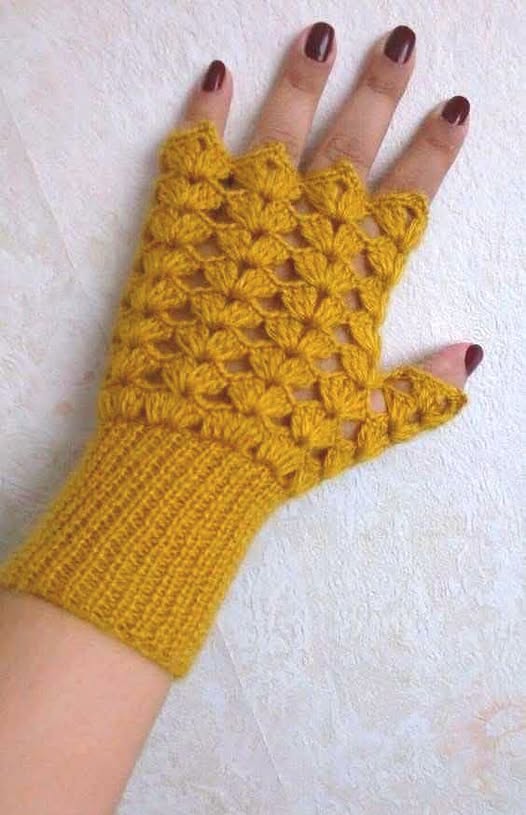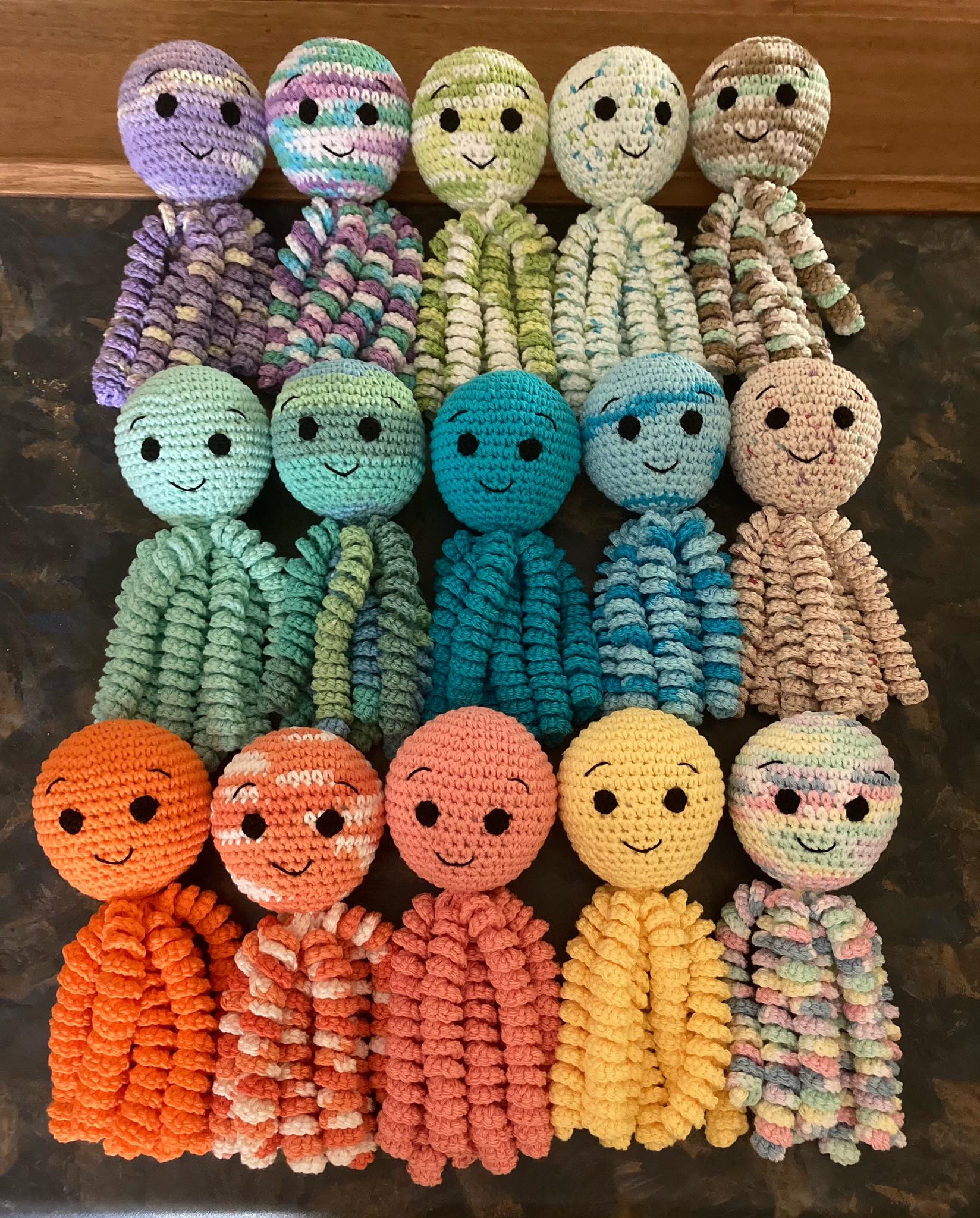
Crochet Octopus for Babies – Amigurumi is a heartwarming and practical project that has gained tremendous popularity among crafters, parents, and NICU nurses alike. These tiny, soft creatures are not just adorable keepsakes; they also serve a comforting purpose for newborns, especially premature babies.
With their spiral tentacles and gentle texture, crochet octopus for babies – amigurumi mimics the feeling of an umbilical cord, offering a sense of security and calm to little ones during their earliest days.
The use of crochet octopus for babies – amigurumi in neonatal units is more than a trend; it’s backed by thoughtful design and heartfelt intention. When held by infants, these crocheted octopuses provide comfort, helping reduce stress and fidgeting with medical tubes.

The tentacles offer something for tiny hands to grasp, which can be both soothing and beneficial for their development. Beyond the NICU, many parents enjoy making or receiving these soft toys as baby shower gifts or nursery decorations.
Crafting a crochet octopus for babies – amigurumi is also a rewarding experience for makers. It’s a small, manageable project that can be completed quickly and offers a meaningful outcome. Whether you’re new to crochet or a seasoned amigurumi artist, this pattern combines basic shapes, playful color choices, and functional design. In this guide, we’ll walk through materials, steps, safety tips, and creative ideas to help you make your own lovable sea creature.
The unique shape of the crochet octopus for babies – amigurumi isn’t just cute—it’s comforting. The curled tentacles resemble the coiled shape of the umbilical cord, which babies instinctively recognize. This familiar texture brings them calm and helps ease the transition from womb to world.
Another reason to choose this project is its portability. The finished octopus is small enough to fit in a baby’s hand or be placed safely beside them. Its compact design also makes it ideal for hospital use or travel.
These crochet octopuses are easy to sanitize. Since they’re made with 100% cotton yarn and stuffed with hypoallergenic fiberfill, they can be machine-washed and air-dried. This is especially important for infants with sensitive skin or medical concerns.
From a crafting standpoint, this amigurumi pattern is beginner-friendly. Basic crochet stitches like single crochet, increases, and decreases form the foundation. The tentacles are made by creating chain stitches and working in rounds or rows—an excellent technique for beginners to practice.
Because it’s a small project, it requires minimal yarn and tools. Many crafters use leftover yarn from larger projects, making this a sustainable and budget-friendly craft. You can finish an octopus in just a few hours, making it a perfect gift or charity contribution.
Finally, the emotional impact of gifting a crochet octopus for babies – amigurumi cannot be overstated. Whether donated to hospitals or made for a loved one, these toys symbolize care, comfort, and connection in a deeply personal way.
To make a crochet octopus for babies – amigurumi, selecting the right materials is essential for both safety and durability. Begin with 100% cotton yarn, as it is soft, breathable, and safe for infants. Avoid synthetic fibers, which may irritate delicate skin or pose flammability concerns.
Use a smaller hook than recommended for the yarn—typically a 2.5 mm or 3 mm crochet hook—to ensure tight stitches that won’t expose stuffing. This keeps the toy firm and prevents little fingers from pulling out fiberfill.
Choose a high-quality hypoallergenic stuffing material. Polyester fiberfill works well and maintains the toy’s shape over time. Ensure it’s evenly packed but not overstuffed, which could distort the shape or stretch the stitches.
You’ll also need safety eyes or embroidered features. For babies, embroidered eyes made with cotton thread are the safest choice. Avoid plastic safety eyes if the toy will be used by newborns or infants who may try to chew on it.
Gather a yarn needle for sewing pieces together and a pair of sharp scissors. Stitch markers can be helpful for keeping track of rounds, especially when working continuously in the round (spiral method).
Before you begin, review your pattern thoroughly. Reading ahead ensures you understand all components—such as the head, tentacles, and facial features—before you start stitching. You’ll enjoy smoother progress and more confidence throughout the process.
Start your crochet octopus for babies – amigurumi with a magic ring, working in continuous rounds to build the spherical head. Most patterns begin with 6 single crochets in the ring, followed by even increases to form a dome.
Once the top of the head is wide enough, maintain the diameter by working single crochets in each stitch for several rounds. This forms the midsection of the octopus’s head and gives it height and volume.
Begin to decrease evenly to close the head, but pause when it’s 75% finished to insert stuffing. Use your fingers to gently pack the fiberfill in small amounts, shaping it evenly to avoid lumps. Finish the decreases and fasten off securely.
The tentacles are made separately using chain stitches. Chain about 35–40 stitches, then work two single crochets in each chain to create a curly effect. Repeat this 8 times for 8 tentacles. Some crafters crochet them directly onto the base; others sew them on.
Stitch the tentacles evenly around the underside of the octopus’s head. Make sure they’re securely attached and won’t come loose. Each one should curl naturally due to the increased stitches, creating the familiar spiral shape.
Finish the octopus with facial features. Embroider simple eyes and a smile using black or dark brown yarn. Be sure all ends are securely knotted and hidden inside the head. Your crochet octopus for babies – amigurumi is now ready to cuddle!
When making a crochet octopus for babies – amigurumi, always prioritize safety. Never include buttons, beads, or detachable parts. Everything must be sewn on securely and crafted with materials safe for infant use.
Regularly check your finished octopus for wear and tear, especially if it’s handled often. If the tentacles become loose or stitches start to stretch, make repairs immediately or retire the toy from baby use.
To make it even more special, customize the colors. Soft pastels are popular, but bold primary colors or sea-inspired hues can also look beautiful. Just ensure the yarn is colorfast and won’t bleed during washing.
Consider adding textures to the tentacles. Some makers use puff stitches or bobbles to create a more tactile experience for babies. These different textures can help with sensory development.
Another creative idea is to add a small rattle insert inside the head. Make sure it’s well-encased and won’t shift around. This adds auditory stimulation without overwhelming the baby.
You can also adapt the pattern to make keychain versions, mobiles, or nursery décor. Once you’re comfortable with the basics, scale the size up or down and experiment with creative embellishments for different occasions.
Q: Why are crochet octopuses used for babies?
A: Their tentacles mimic the feel of an umbilical cord, which soothes newborns, especially preemies. They offer comfort and a sense of security in incubators or cribs.
Q: Is it safe to give a crochet octopus to a baby?
A: Yes, as long as it is made with 100% cotton yarn, hypoallergenic stuffing, and embroidered features. Avoid small parts like buttons or plastic eyes.
Q: What size should the finished octopus be?
A: Around 6–8 inches tall, with tentacles no longer than 6 inches when stretched. This ensures it’s safe for small hands without posing entanglement risks.
Q: Can I wash the crochet octopus?
A: Absolutely. Use gentle, fragrance-free detergent and wash in a delicate bag if machine washing. Air dry completely before giving it back to the baby.
Q: Can I sell crochet octopuses for babies?
A: Yes, but make sure you follow safety regulations for infant toys in your country. Be transparent about materials used and suggest supervision during use.
Q: Where can I donate crochet octopuses?
A: Many hospitals accept them, especially NICUs. However, contact them first, as some have specific size and material guidelines for donations.
In this article, we explored the wonderful world of the crochet octopus for babies – amigurumi, a project that is as meaningful as it is adorable. You’ve learned why these little sea creatures are so loved in neonatal care, how to choose safe materials, the step-by-step process to crochet one, and fun variations you can try.
Creating a crochet octopus for babies – amigurumi is more than just crafting—it’s a gift of comfort, love, and support. Whether you’re making one for a newborn in your life or donating to those in need, each stitch carries warmth and care.
Have you tried making one yourself? We’d love to hear your experiences! Leave a comment below with your thoughts, suggestions, or any questions you still have. Let’s keep this tradition growing and spreading joy—one tiny tentacle at a time.
